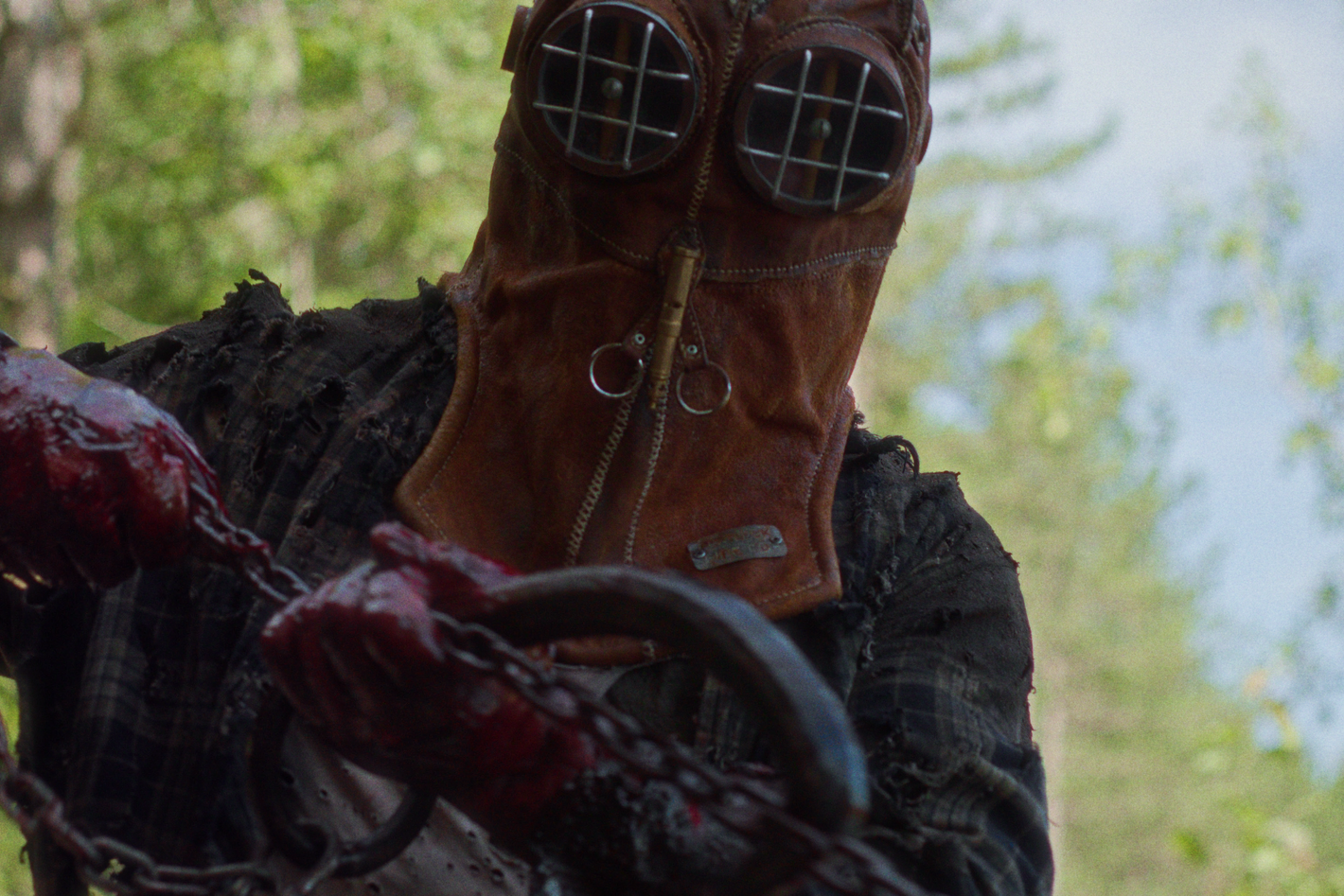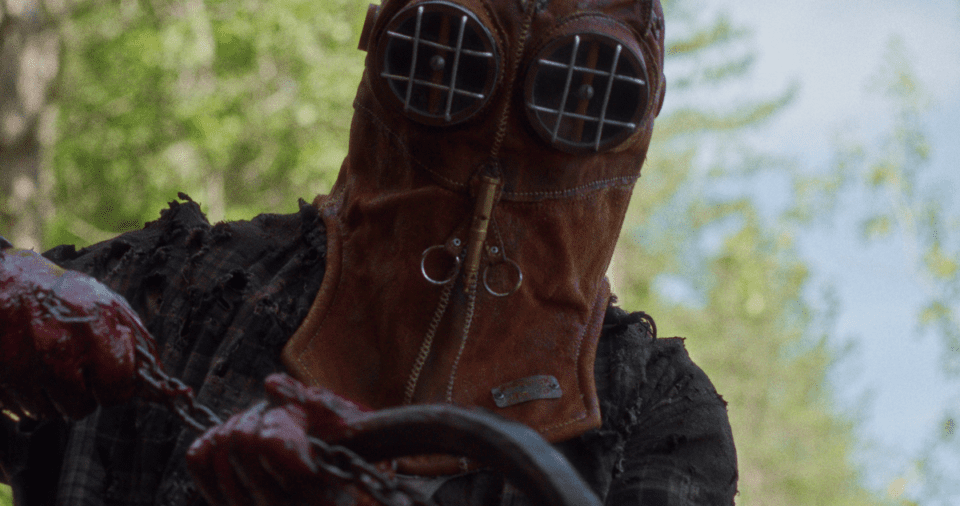
Spoilers follow for In a Violent Nature, in theaters now.
A great kill scene in a slasher movie inspires more than shock, terror, or disgust. It gets you high on the sheer audacity of the violence. Gasps become winces. Winces crack into laughter. Clapping greets the electric current of stunned disbelief that passes through the audience. Whether taking in the borderline-comic killing sprees of Jason Voorhees or the proudly obscene rampages of Art the Clown, what midnight moviegoers applaud is a filmmaker’s willingness to go there — to push the limits of good taste and gallows humor, and to drag us with them over the top.
There’s a kill of that caliber lurking near the midway mark of In a Violent Nature, an arty, unconventional new addition to the canon of thrillers about masked maniacs trudging through the woods in search of nubile co-eds to dismember. The scene in question is already notorious, its reputation preceding Nature’s theatrical release this week. At a recent late-night festival screening in Chicago, people reacted to it like theme-park guests on a roller coaster. Someone may have even vomited, though that could also be apocryphal; I was there and heard no retching over all the empathetic groans and emphatic cheering.
The scene arrives after some 40 minutes of almost meditative woodland wandering broken up with occasional bursts of carnage, though the film has saved its most inventively, anatomically extreme mayhem for the centerpiece to come. (The squeamish and spoilerphobic alike should take this as warning to click away now.) Having just dispatched a swimming vacationer — a death we witness from a great distance, free of all titillation — the movie’s hulking, silent killer stumbles upon her blonde lover (Charlotte Creaghan) doing yoga in a clearing. Cornered, the young woman screams and backs away but finds herself facing a steep bluff. Given what happens next, she’d have been better off taking her chances with a long roll down the embankment.
A swift, inhuman punch sends the killer’s hand — and the chained hook it’s brandishing — straight through the woman’s torso. In a trance state of shock, she slowly turns to face her masked murderer, who then pulls the hook back through and promptly plunges it into the top of her head. Is this depraved spectacle over? No, it continues unabated, as the killer then turns his victim to face the water again and yanks on the chain still dangling in her midsection — a grotesque indignity that gruesomely breaks her neck and pulls her head down and forward and then (cue barf bags) through that same bloody, gaping hole where her stomach should be. He’s effectively perverted her exercise routine, stretching her into a nightmarish yoga pose of death.
As far as slasher fatalities go, it’s an all-timer. Were the film an official entry in the Friday the 13th series, rather than a curious, methodical tone-poem tribute to the same, this innovatively nasty slaying would land instantly near the top of a Voorhees-kill-count power ranking, challenging the standing of Kevin Bacon’s date with an arrow or that time Jason dunked someone’s head into liquid nitrogen. This is the moment horror fans will likely spend the year excitedly recalling and the single scene on which the movie’s reputation as a must-see for gorehounds hinges (though there’s a later sequence involving paralysis and a wood-chopping machine that’s arguably even gnarlier).
But the scene also confirms the kind of movie In a Violent Nature really is. Up until the big boy gets fiendishly creative with his makeshift weaponry, it’s possible to wonder if director Chris Nash is using the basic conventions of his borrowed genre premise to go somewhere new. The gimmick of the film is that it chiefly unfolds from the killer’s perspective — a full extension of the way the Friday the 13th and Halloween movies sometimes briefly adopt the first-person POV of Jason and Michael Myers. Here, the ratio of identification has been flipped, so that we’re mostly following the monster, and only briefly being put in the shoes of his prey. This change in vantage scrambles the language of the typical slasher movie: Because the killer is essentially a mute animal (unlike the deranged protagonist of grimy ’80s slasher Maniac and its remake), sticking close to him results in long scenes of wordless, plotless hiking. The result is closer in style and rhythm to the doomy slow-cinema dirges of Gus Van Sant, like Elephant or Gerry.
But there’s nothing so philosophical going on in this movie. That grisly scene of the Jason-like stalker twisting someone into herself like a cherry stem tied into a knot gives away the game. It drops the pretense of abstracted violence (like an earlier scene that cuts away right before the brute bloodies his mitts) and delivers the gory goods. At heart, In a Violent Nature isn’t an art film playing on horror tropes but something like the inverse: a pitiless old-school slasher that simply takes a roundabout and rather scenic path to the usual scuzzy thrills. Nash subverts the form of the slasher movie but not the content. From a plot perspective, there are no big twists.
The ambient stretches, the following shots that hold and hold on the killer as he ambles through the wilderness in search of his next kill — these eccentric plays on duration are like a hockey mask pulled over the can-you-top-this spirit of ’80s slasher cinema. Mostly, they delay the familiar genre-buff dopamine hit of limb-chopping action. In so much as Nash has deconstructed the slasher, it’s to find out what you can cut from its formula while still staying true to its, well, violent nature. Are actual characters necessary? Dialogue? A story? How much uneventfulness will audiences put up with if you’re still providing the raison d’être, the murder and mutilation?
Still, for all Nash takes away, he adds plenty in the craft department. In a Violent Nature is proof that even just toying with conventions can have exciting results. If nothing else, slasher cinema would benefit from the attention to framing and pacing the director applies to his stripped-bare conceit; no actual Friday the 13th movie has ever been this well shot or attentive to mood. In taking inspiration from the art house, Nash refines or at least eccentrically differentiates his grind-house material.
And that goes for his already-historic, Grand Guignol kill with a view, too. Another, ahem, hook of the barbaric encounter is how deliberately it plays out before us — how Nash lingers on details, like the splinter of the cervical spine, or the breathtaking wide shot he deploys to emphasize the altitude that dooms the yogi, the long fall that’s her only alternative to brutal evisceration. More than just the absurd extremity of the murder, it’s the elegant sequencing of Nash’s imagery and his commitment to prolonging the psychic limbo state of the violence that pushes this date with death into the slasher set-piece pantheon. A little patience can make a big difference, even in the ongoing arms race of elaborately appalling kill scenes.
A.A. Dowd , 2024-05-31 14:00:39
Source link


